From the history of own names of aircraft of Russia in 1930-ies
A significant role in this work continued to be assigned to nominal aircraft, which served as a kind of advertisement for the inextricable link between the Red Army and Soviet society. As in the 1920-s. Across the country, actions aimed at equipping the Air Force with new military equipment using popular funds raised for voluntary donations continued.
Despite the previously established rules according to which aircraft could receive only the names of outstanding people who had passed away, the process of assigning the names of the party and state elite to the planes (gliders) and the leaders of the Red Army began in favor of the cult of “leaderism” spread in the country. Among the first such honor was awarded to the fighter type "I-5", decorated with the name "Klim Voroshilov»1, at that time, Commissar of Defense of the USSR and one of the closest associates of I.V. Stalin. On this plane, the head of the Red Army Air Force (1931 - 1937) Ya.I. Alksnis2 periodically inspected aviation parts of Moscow region3. In honor of Alksnis himself, a single-seat experimental hydroplane “G-12” designed by V.K. Gribovsky, built in 1933
More original did the famous aircraft designer Alexander Yakovlev4by encrypting in the name of the aircraft under the abbreviation "AIR»Initials of their high patron - Chairman of the Council of People's Commissars of the USSR Alexey Ivanovich Rykov5. Later in the USSR several series of aircraft of this type were launched. But, followed in the middle of 1930's. in the country political processes against the so-called. "Enemies of the people", including and A.I. Rykov, finally closed this project.
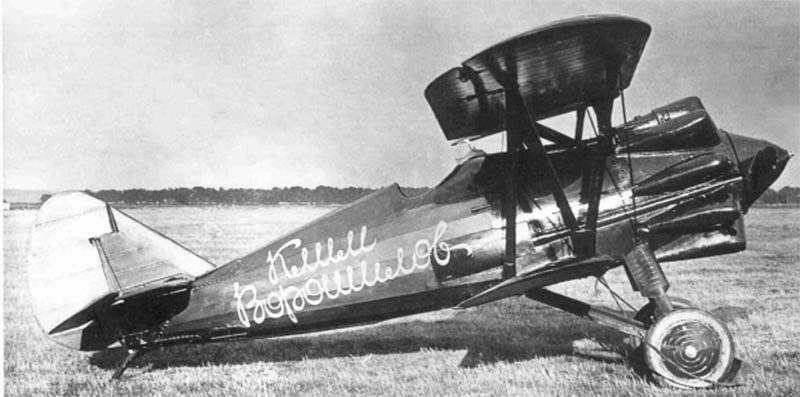
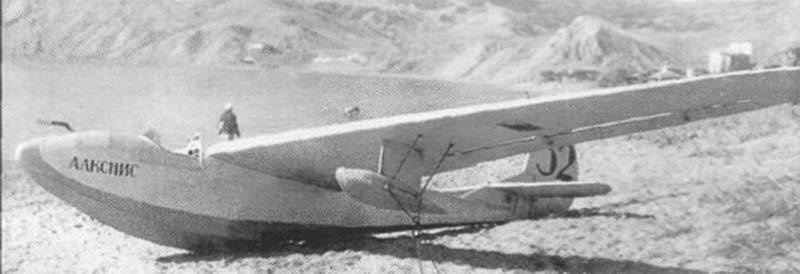
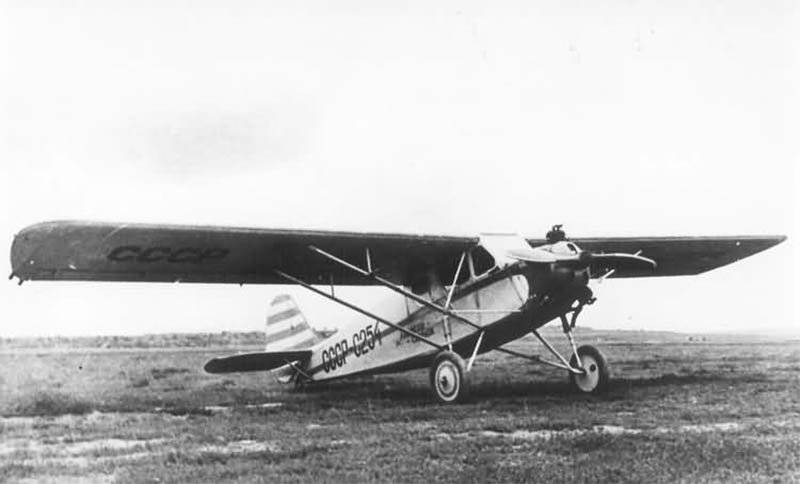
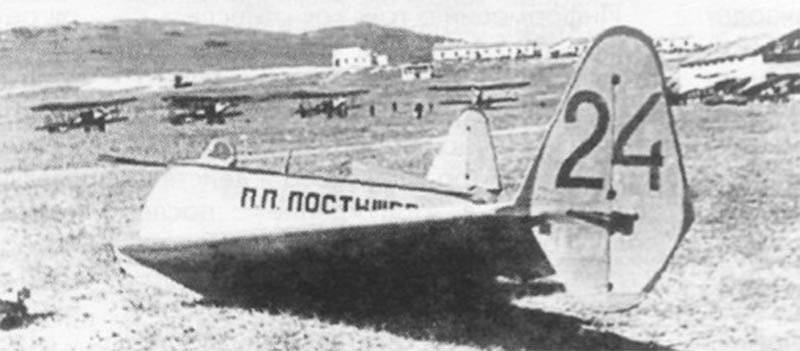
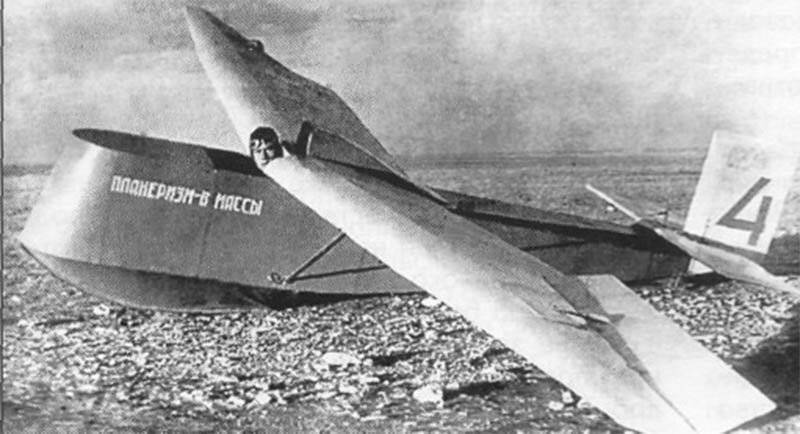
The same fate befell the glidersP.P. Postyshev»6 (constructions of PG Bening, 1934), “ER” (Eideman Robert)7 (design by Antonov OK (6 modifications), 1933 - 1937). Military and state leaders, in whose honor they were named, were victims of Stalin’s tyranny. Meanwhile, the country's air spaces continued to plow gliders with the names "Stalinets"(Various modifications, designs by PA Eremeyev),"Sergo Ordzhonikidze»8 (designs by BV Belyanin) and others. The processes taking place in the country, associated with the rapid renewal of the governing bodies in the upper echelon of power, were also reflected in the name of the aircraft.
The trend continued to assign whole aviation units and parts of the names of state and party leaders of the country. In 1930 as part of the Red Army Air Force appeared "Fighter Aviation Brigade named after SS. Kamenev9»10, “Squadron named after MI Kalinin11 "," Light Aviation Squadron of the Aircraft Brigade of the Scientific Research Institute of the Air Force of the Red Army named after N.V. Krylenko12»13, "3 separate aviation squadron named after t. Ordzhonikidze"14, "201 Light Bomber Aviation Brigade named after T. K.E. Voroshilov "15 etc. This concerned not only the living and well-established representatives of the military-political leadership of the state, but also those who had already died. So, in connection with the tragic death of a prominent party leader of the country, the first secretary of the Leningrad Regional Committee of the CPSU (b) S.M. Kirov16 Many military units and military schools of the Red Army were named in his honor. As part of the Air Force, the 3 th Special Aviation Brigade was awarded this right.
PEOPLE'S COMMISSIONER OF THE USSR DEFENSE17 № 085
December 27 Moscow 1934
On the assignment of the 2 air defense division and 3 to the aviation brigade of the United Soviet T. Kirov S.M.
To perpetuate the memory of the secretary of the Central and Leningrad Committees of the CPSU (b) t.Kirov Sergey Mironovich, who died from the treacherous hand of the enemy of the working class, assign 2 air defense divisions and 3 to the special purpose aviation brigade named Sergei Mironovich Kirov.
Henceforth, these military units to call:
1. “The 2nd Air Defense Division named after S.M. Kirov ".
2. “3rd Special-Purpose Aviation Brigade named after S.M. Kirov ".
People's Commissar of Defense of the USSR K. Voroshilov
In the first half of 1930. a number of units and institutions of the Red Army Air Force were named after famous military pilots and military leaders, who also tragically passed away: PI Baranov - Chief of the Red Army Air Force (1925 - 1931)18, P.H. Mezheraupa19 (inspector of the Red Army Air Force), V.I. Pisarenko (Senior Assistant Inspector of the Red Army Air Force)20 and more
Special place in stories of the domestic aviation of that time was occupied by a specially formed aviation propaganda squadron named after AM Gorky21. Practically all the aircraft that were part of it were named after the leading Soviet newspapers and magazines - Pravda (ANT-14), Iskra (Dn-9), Krestyanskaya Gazeta (ANT-9), Ogonek (K -5), Krasnaya Gazeta (AIR-6), etc. So, ANT-9, damaged during an emergency landing, was repaired and a new name was given to it - Crocodile (after the satirical magazine popular in the USSR). For greater persuasiveness, the nose of the airship was depicted as a grin of a tropical reptile.
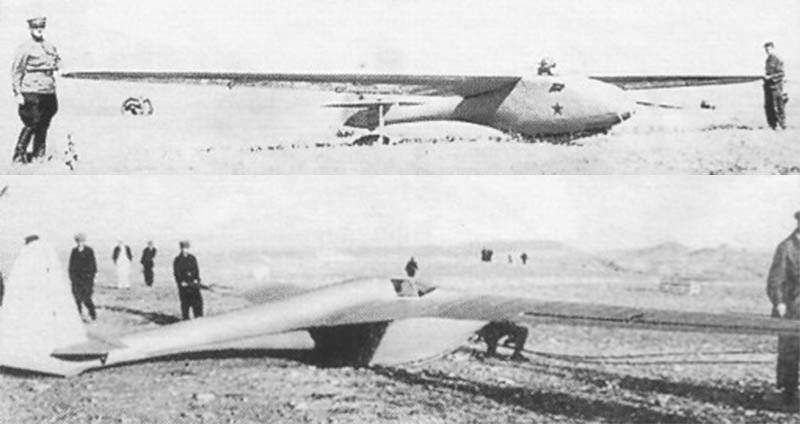
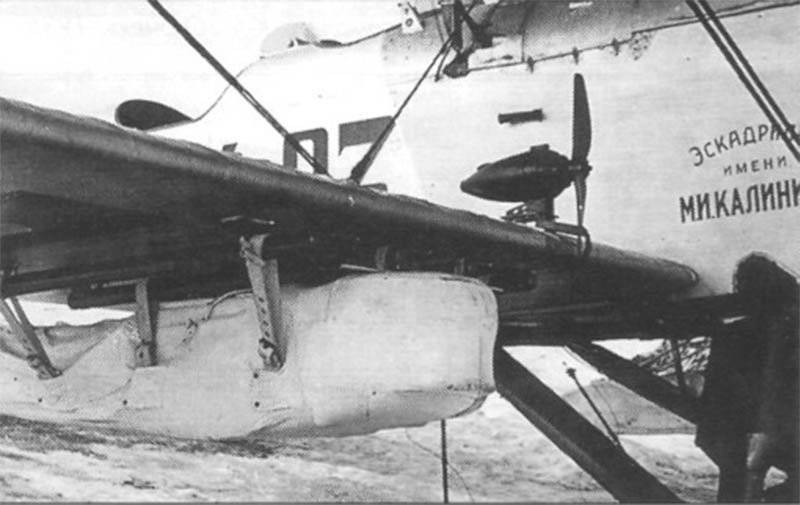
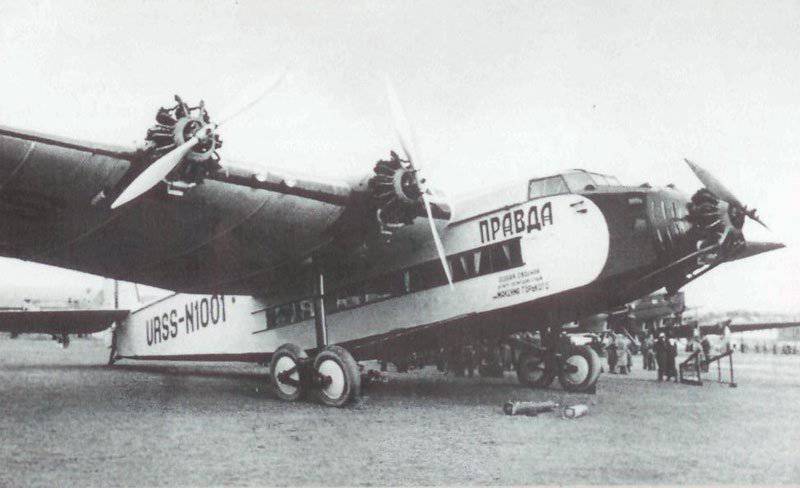
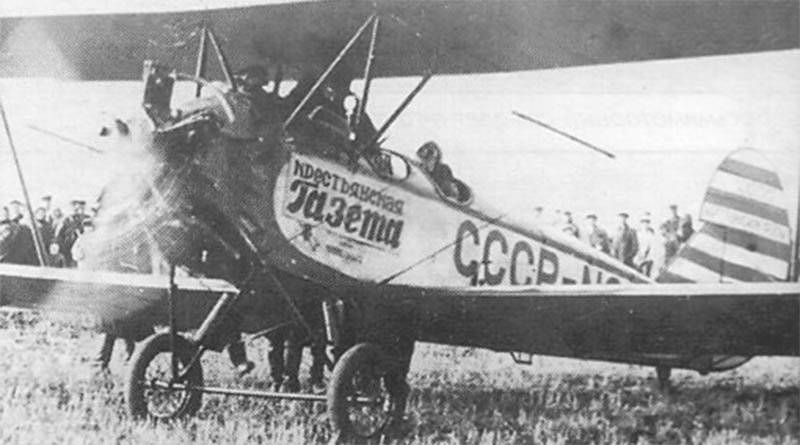
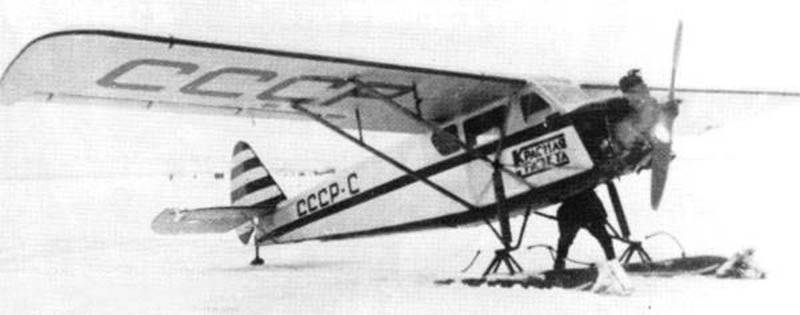
The eight-engined giant Maxim Gorky (ANT-20) became the leader of the agitation squadron.22, created under the general guidance of the famous Soviet aircraft designer A.N. Tupolev23 and named in connection with the fortieth anniversary of the literary and social activities of the great Russian writer AM Gorky. Unfortunately, the fate of the plane was tragic. 17 May 1935 in the sky over Moscow, a collision of an air giant that made a pleasure flight, with one of the E-15 fighter aircraft (No. XXUMX) accompanying it. Pilot fighter military test pilot TsAGI N.P. Blagin24during the execution of an unplanned aerobatic maneuver near "Maxim Gorky", inadvertently crashed into it. In a plane crash, 47 people died, including test pilots, crew (11 people), TsAGI employees and their families. The country has lost a unique, unique aircraft of its kind.
From the materials of the newspaper "Pravda" 20 May 193525
In the second round, “Maxim Gorky” made a turn to the left and went towards the airfield .... Blagin, being on the right wing, despite the ban, made the right “barrel” (one of the complicated aerobatic maneuvers) and withdrew from inertia to the right the aircraft. Then he moved to the left wing ... he added gas, pulled ahead and suddenly began to make a new aerobatics. It was very dangerous, as it could drag him to Maxim Gorky by inertia. The figure he failed, he lost speed and crashed into the right wing of the "Maxim Gorky", near the middle motor. ... The blow was a monstrous force. "Maxim Gorky" tilted to the right, a black hood and pieces of a training plane flew from it [erroneous assessment: the I-5 was a fighter]. "Maxim Gorky" flew by inertia for another 10-15 seconds, the list increased, and he began to fall on his nose. Then a part of the fuselage with a tail was torn off, the plane went into a steep dive and turned over onto its back. The car hit the pines, began to demolish the trees and finally crumbled on the ground.
According to individual experts, this tragedy was the result of the beginning of the popular aerobatics in the country. Russia experienced the first boom of breathtaking demonstration flights on the eve of the First World War, when outstanding Russian and French aviators showed their skills in the country's sky. As in 1910-s. air holidays with virtuoso acrobatic figures again gathered tens of thousands of spectators, which greatly expanded the interest in aerobatics in society.
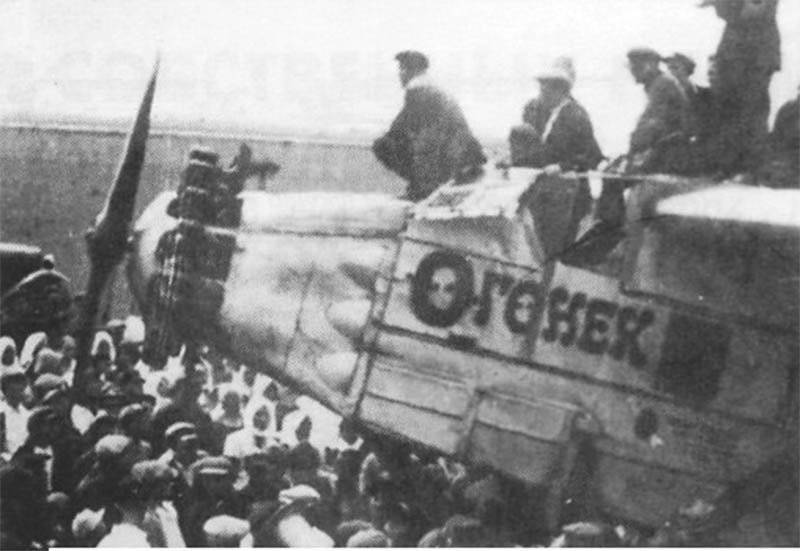
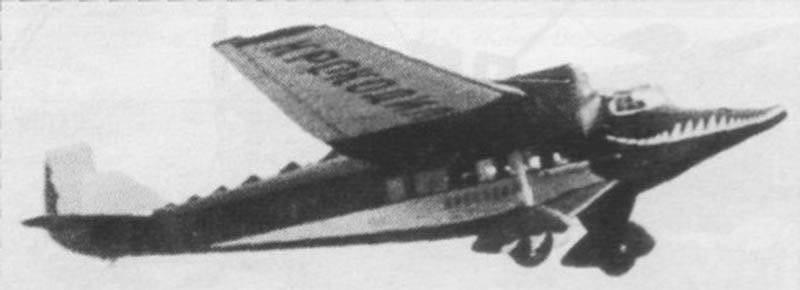
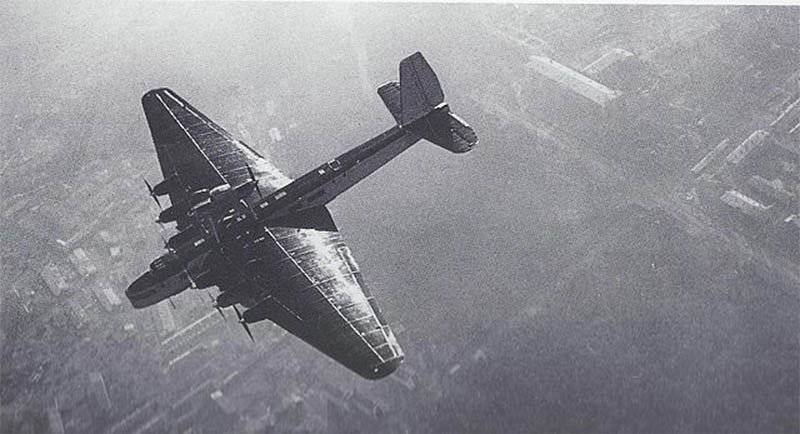
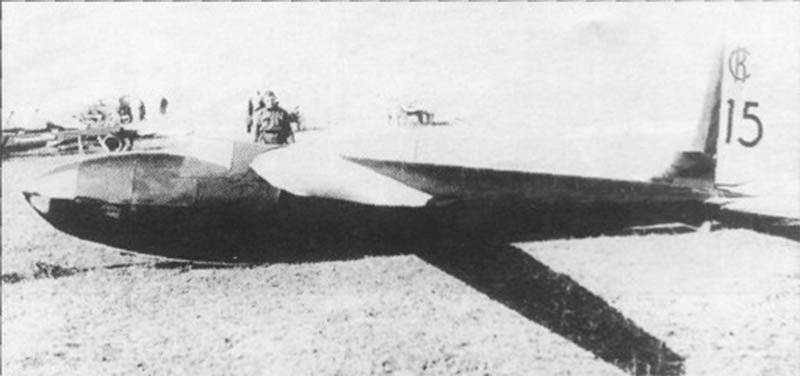
The representatives of non-powered aviation also did not stand aside. One of the best gliders of the USSR at the turn of 1920 / 1 930-s. Vasily Andreyevich Stepanchonok 28 October 1930 for the first time in the world on the Red Star single-seater glider SK-3 (designed by S. Korolev, 1930) performed the “dead loop” aerobatics (3 times).
According to the airframe designer “The construction of such a machine was intended to practically prove the possibility of producing aerobatic flying figures on a glider in general. The only experience in this direction was made in America, but the pilot Haze, who made the 4 loops, used the help of the plane towing his glider to climb. Thus, for a glider-glider, self-gaining height, a similar task was set for the first time. ”26.
Later on the glider “G-9” (designed by V.K. Gribovsky) V.A. Stepanchonok managed to repeatedly perform the “dead loop” (115 times), and the next flight the number of loops already reached the number of 184. Vasily Andreevich glider aerobatics served as the beginning of the development of aerobatics in our country and in the world. At the VI 11 th rally of glider pilots (Koktebel, 1930) V.A. Stepanchonk on the same glider "G-9" for the first time in the world has mastered such aerobatics as a coup through the wing, a corkscrew, flying on the back. Here he began training in aerobatics of others. Soon his students demonstrated these figures at aviation festivals in Tushino.
It is necessary to indicate that the airframe “P.P. Postyshev ”was also able to perform aerobatics. So on the 10 aeronautical rally, the pilot L.S. Ryzhkov successfully performed the “loop of Nesterov” and other aerobatics, and S.N. Anokhin made a parachute jump from a very low altitude with him using the disruption method. According to its flight characteristics, the glider was recognized as one of the best flight pilots.
Solving propaganda tasks, the inscriptions on the sides of aircraft and gliders sometimes reflected the current history of the country. Thus, the arisen Soviet-Chinese armed conflict (1929) was immediately reflected in the form "Our response to the White Chinese bandits", and the complex relationship of the Soviet leadership with the Vatican - "Our response to the Pope." Sometimes the names of the aircraft had a curious origin. So, created in 1932 by the designer V.K. Gribovsky, a single training glider was sent by rail to the city of Koktebel to the Higher Flight and Glider School. On the way, the carriage with the glider was lost somewhere and arrived at the school only six months later, already in 1933. In connection with such a long delay, sharp-tongued school instructors, believing that the glider wandered along the country's railways like a homeless child, named it "Homeless". Later the glider took part in the IX and X aeronautical rallies of the country.
With the establishment of the high rank of Hero of the Soviet Union in the USSR (1934), individual planes soon became decorated with this inscription. In addition to the title itself, the first pilots who received this honorary title received special popularity in the country. The names of some of them were soon sealed on the aircraft. The first such honors were the pilots MM. Gromov and M.V. Vodop'yanov. So, on the initiative of the Azov-Black Sea Aeroclub, the glider-type "monoplan-parasol" was named the head of this club - "Mikhail Vodopyanov"27.
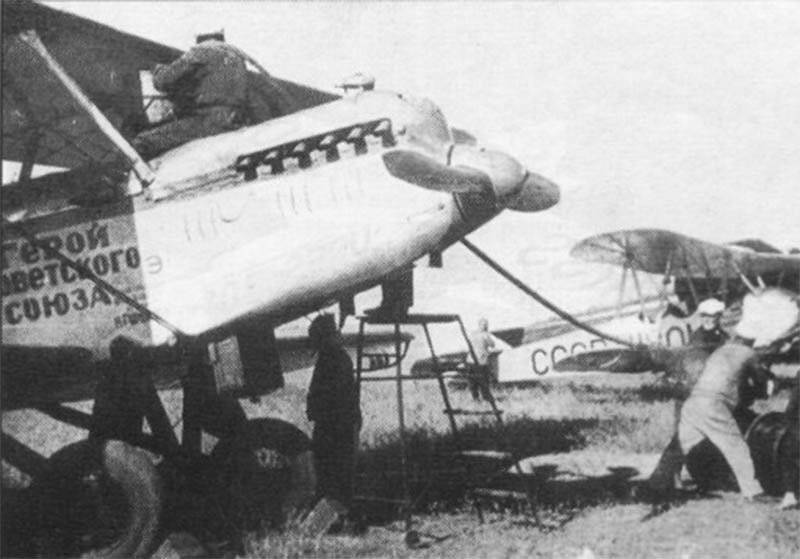
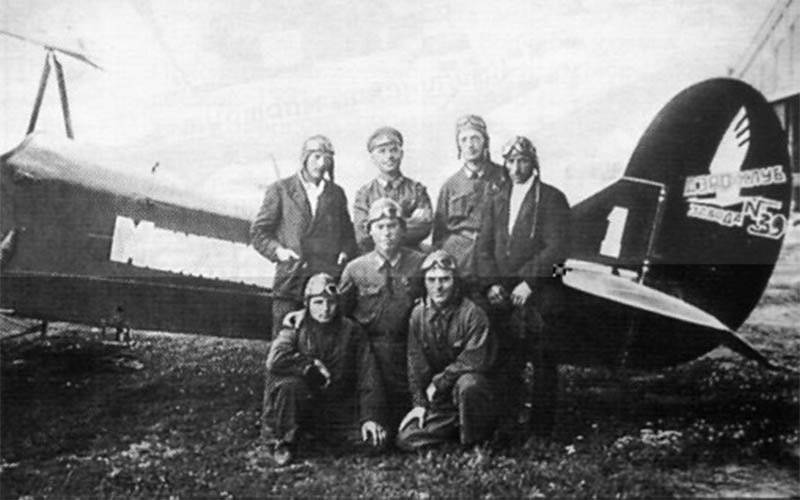
In the meantime, the national construction and equipping of Soviet aircraft with new military equipment continued in the country. Published orders RVS USSR (later NPO USSR), it was included in the aviation units and units.
REVOLUTIONARY MILITARY COUNCIL OF THE UNION OF SOVIET SOCIALIST REPUBLICS28
№ 114
17 June 1933 Moscow
The arrows, the command-political staff and the personnel of the VOKhR of Ukraine, in addition to the already transferred 15 planes, are transferring the 5 planes built by them to the Workers 'and Peasants' Red Army.
Noting the exceptional activity and high revolutionary consciousness shown by the arrows, the composition and the personnel of the VOKhR in strengthening the defense capability of the USSR, I order:
1. Include in the Red Army Air Force transmitted planes and assign to them, according to the desire of the VOKhR drummers, the names:
1) "Air Defense Drummer",
2) "Name of Thälmann",
3) "In the name of Frunze",
4) "5 in 4",
5) "In the name of Budyonny".
2. Satisfying the petition of the CA of Osoaviakhim of Ukraine, assign the 3 to a separate aviation squadron of the Air Force, to which all these aircraft were transferred, the name:
"3 separate aviation squadron named after t. Ordzhonikidze."
People's Commissar for Military and Maritime Affairs and Chairman of the Revolutionary Military Council of the USSR Voroshilov.
Representatives of the army and fleet. So, the soldiers of the Moscow Military District built on their savings aircraft named after the 81st Infantry Division and the name of the military school named after the All-Russian Central Executive Committee. In June 1930, the personnel of this school took the initiative to build a squadron of aircraft named after the 5th Congress of the CPSU (B.) And for this purpose made an initial contribution to the State Bank in the amount of XNUMX thousand rubles.
The people's contribution to the common cause of the development of Soviet military aviation was invariably reflected in the new names of the air formations, which were officially approved in high-level governing documents. In the period 1932 - 1934. as part of the Red Army Air Force, many nominal units and units appeared, including: “54 is a separate aviation detachment named for“ Petroleum industry workers of the Transcaucasus ”29, “Aviation Squadron named after 5 All-Union ITR Congress”30, "11 military school of pilots named after the Donbass proletariat"31, "255 Aviation Brigade named after the Kiev region proletariat"32 and more
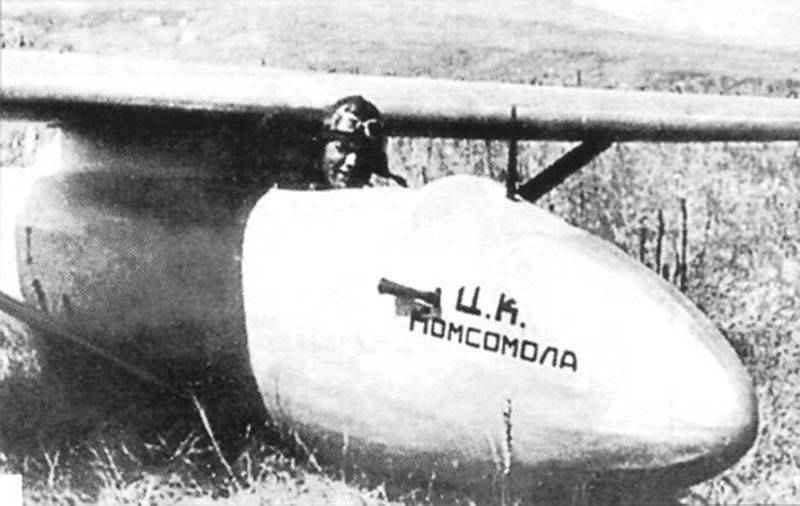
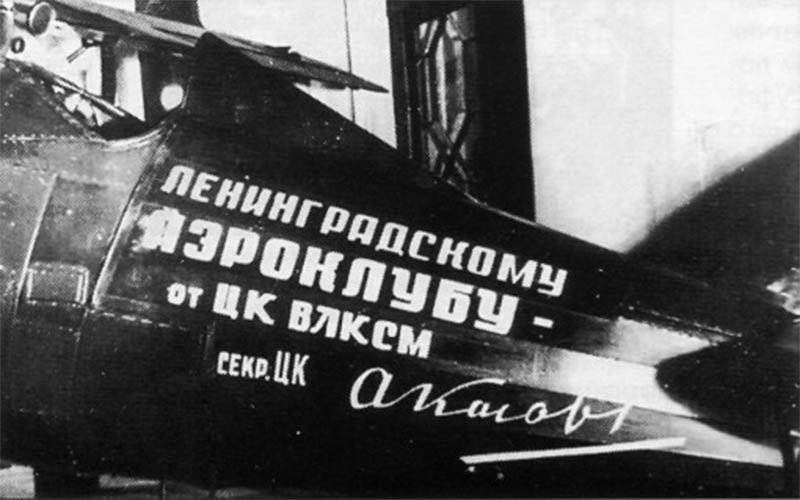
His significant contribution to the development of the Red Army Air Force made and Lenin Komsomol. 25 January 1931, the XI Congress of the Young Communist League addressed all the Komsomol members of the Soviet Union, the soldiers and commanders of the Red Army Air Force with the words: “Together with the party and the entire working class of the country, we are responsible to the proletariat of the world for the defense of the USSR and are obliged to make it the central task of our work ... the Congress of the Komsomol on behalf of the three millionth Red Banner Army of the Leninist Komsomol decides to take charge of the Air Force of the Red-Army Workers and Peasants . From now on, the fate of the Leninist Komsomol is inextricably linked with the fate of the Air Force of the Red Army, which gives both more strength, more combat proletarian power. ”
Taking patronage over the Air Force, the Komsomol threw a cry: "Komsomolets - on the plane!". Following this appeal, the Soviet youth on Komsomol trips in the coming years significantly expanded the aviation industry, flight and technical military schools, as well as numerous flying clubs of the country. Having appreciated the help and support of the Komsomol Central Committee, the leadership of the Red Army formalized its close cooperation with the Komsomol, issuing a number of relevant orders on this matter.
REVOLUTIONARY MILITARY COUNCIL OF THE UNION OF SOVIET SOCIALIST REPUBLICS33
№ 9
27 January 1933 Moscow
/. On the assignment of the Moninskaya Aviation Brigade to the Red Army Air Force in the name of the All-Union Lenin Communist Youth Union.
2. On awarding the rank of honorary pilot of the brigade to the General Secretary of the Central Committee of the Komsomol t. Kosarev A.V.
Noting the exceptional work of the All-Union Leninist Communist Union of Youth in building the Moninsky Aviation Brigade of the Red Army Air Force, attention and care from the Komsomol Central Committee to the entire staff of the aviation brigade, the active participation of the Komsomol in the struggle for trouble-free operation and for a high level of political and educational work on personnel, to commemorate 2 anniversary of the patronage of the Komsomol of the Red Army Air Force, I order:
1. To assign the name of the All-Union Leninist Communist Youth Union to the Monino Aviation Brigade of the Red Army Air Force.
2. To confer the title of honorary pilot of the brigade to the General Secretary of the Central Committee of the All-Union Leninist Young Communist League t. Kosarev A.V.
People's Commissar for Military and Maritime Affairs and Chairman of the Revolutionary Military Council of the USSR Voroshilov
In the coming years, many military aircraft were decorated with inscriptions that vividly confirm the inseparable connection of the Komsomol with Soviet aviation.
Continued in 1930. long-distance flights of Soviet aviators were also reflected in the text art, cultivated on board the aircraft. In order to propagate the achievements of Soviet aviation, aircraft that were directly involved in the flights received specific names. Among the first ones, the “Land of Soviets” aircraft (ANT-6), which made the first intercontinental flight in the history of domestic aviation, can be called. In the fall of 1929, the aircraft crew was composed of: S.A. Shestakova (commander), F.E. Bolotov (second pilot), D.V. Fufayeva (mechanic) and B.V. Sterligov (navigator) established an "air bridge" between the cities of Moscow and New York (USA). At the same time, the Soviet pilots conducted 1 37 flying hours in the air and during that time passed 21242 km (of which 8000 km above water). Earlier, in 1927, the experienced pilot Semyon Shestakov together with his permanent mechanic Dmitry Fufayev had already had the experience of a super-long flight made on the route Moscow-Tokyo-Moscow.
The flight performed by the crew of the “Land of the Soviets” was of great state importance. During the Great Patriotic War, an air route was built along this route, along which the Soviet Union from the United States received American aircraft of the type “Boston”, “Air Cobra” and others that were so necessary for the needs of the front.
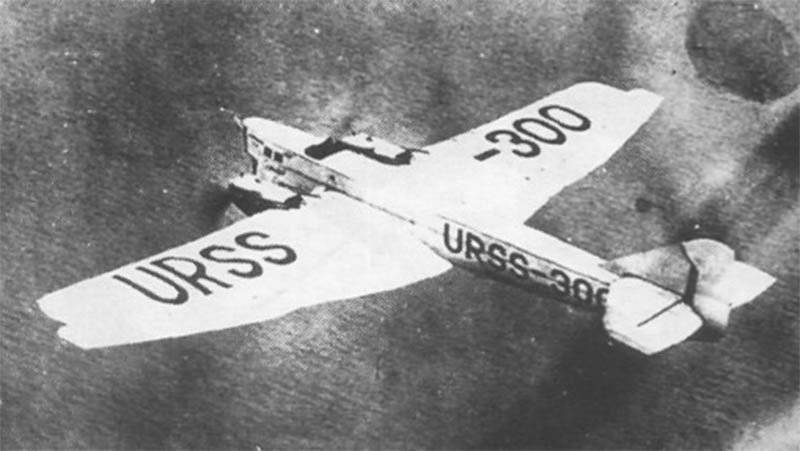
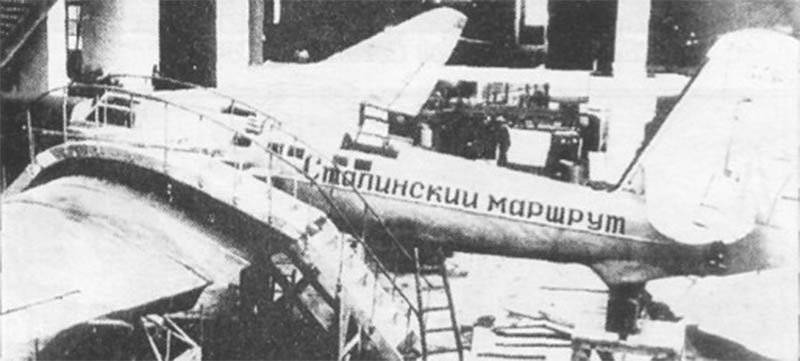
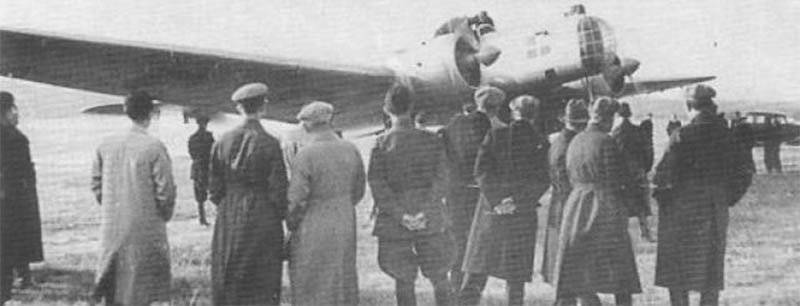
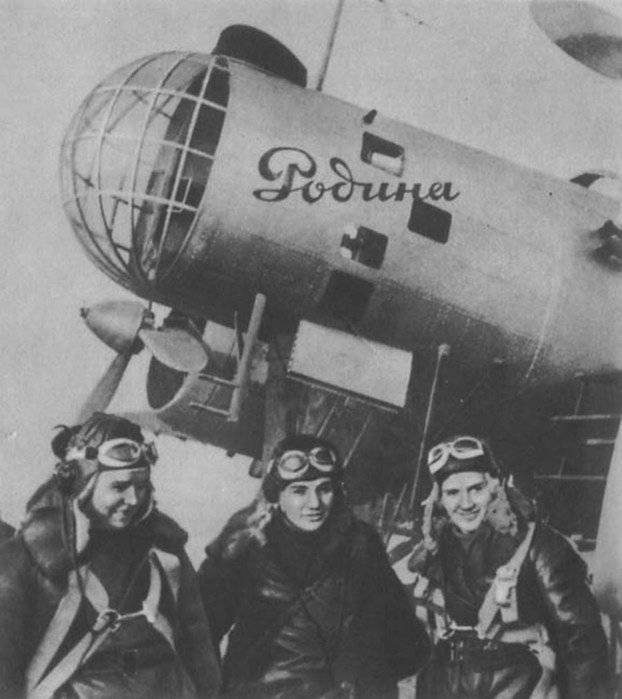
Soon the names of outstanding pilots of the country who participated in long-distance flights appeared on the sides of the aircraft. Thus, in 1934, an ANT-25РД type aircraft was decorated with the inscription “Years. Gromov-Filin-Spirin ", dedicated to the famous in the history of national aviation flight of the Soviet pilots M.M. Gromov34, A.I. Filina and I.T. Spirin35who set the world achievement in range and duration of flight. In the Soviet press of that time, this unprecedented event in the history of Russian aviation noted: “... The famous Soviet test pilot Mikhail Gromov with his crew, co-pilot Alexander Filin and navigator Ivan Spirin, flew into the test record flight in the morning of September 10 1934 in September and drove the car along the triangular route Moscow-Ryazan-Tula. Despite the heavy flight associated with a huge risk to the lives of the pilots, in the morning of September 13, due to the end of fuel in the fuel tanks, the ANT-25РД aircraft made an emergency landing on one of the airfields near Kharkov. During the flight, the crew was in the air 75 hours 2 minutes. Before that, no one in the world had flown for so long. In total, 12411 km was covered by a closed curve. For this feat, the decision of the CEC of the USSR, MM. Gromov was awarded the title of Hero of the Soviet Union. The same resolution A.I. Filin and I.T. Spirin awarded the Order of Lenin ... "36.
The trans-arctic flight from Moscow to the Far East, called “the Stalin route”, received a wide world resonance. The crew of the ANT-25-2 that participated in it included pilots: Valery Chkalov37, Georgy Baidukova38 and Alexandra Belyakov39 managed to build a new air route through the Arctic. In total, the brave pilots of the 56 hours of the 20 minutes of the flight covered the 9374 km. For the ultra-long flight on the route Moscow - about. Udd perfect in 1936, the above pilots were awarded the title of Hero of the Soviet Union.
The women pilots did not lag behind the pilots. By plane "Rodina" (ANT-37 bis, DB-2Б) in the period 24-25 September 1938, the crew consisting of: Valentina Grizodubova40, Polina Osipenko41 and Marina Raskova42 flew for 26,5 hours 5908 km from Moscow to the Far Eastern village of Kerby. The flight took place in difficult meteorological conditions, with freezing cold outside and in the cockpit and ended with a forced landing. For this feat, courageous female pilots were awarded the high title of Hero of the Soviet Union.
Meanwhile, the world was smelling the threat of a new world war, which significantly changed the future lifestyle of the country and its armed forces. The world records in the airspace were replaced by a fierce confrontation for it.
LINKS AND DETAILS:
1 Voroshilov Clement Efremovich [23.01. (4.02). 1881 - 2.12.1969] - Soviet party, state and military leader, Marshal of the Soviet Union (1935), twice Hero of the Soviet Union (1956, 1968), Hero of Socialist Labor (1960). In military service from 1918. During the Civil War: the commander of the 1 Lugansk detachment (1918), the commander of the Tsaritsyn military group (1918), the deputy commander and member of the Military Council of the 10 army, the commander of the Kharkov Military District (1919), commander of the 14 Army (1919), member of the Military Council of the First Cavalry Army (1919-1921). In 1921 -1924 commander of the North Caucasus, then the Moscow military districts. From November 1925 on 1934, the people's commissar for military and maritime affairs and the chairman of the Revision Council of the USSR. In 1934 - 1940 Commissar of Defense of the USSR; from 1938, the chairman of the Main Military Council. In 1940-1941 Chairman of the Council of People's Commissars of the USSR and Chairman of the Committee of Defense at the Council of Ministers of the USSR During the Great Patriotic War, he was a member of the State Defense Committee and the Supreme Command Headquarters, Commander-in-Chief of the North-West Forces (1941), Commander of the Leningrad Front (1941), Commander of the Partisan Movement (1942). In 1946-1953 Deputy Chairman of the Council of Ministers of the USSR. From March 1953 to May 1960. Chairman of the Presidium of the Supreme Soviet of the USSR.
2 Alksnis (Astrov) Yakov Ivanovich [14 (26) .1.1897 - 29.7.1937] - Soviet military leader, commander of 2 rank (1936). In military service with 1917. He graduated from the Odessa Military School of Ensigns (1917), the Military Academy of the Red Army (1924), the Kachin Military Aviation School (1929). He served in posts: officer of a regiment, military commissar of Oryol province, commissar of the 55 th infantry division. From spring 1920 to August 1921, Assistant Commander of the Oryol Military District. In the period 1924 - 1926. Assistant Chief of the Organizational-Mobilization Directorate, Chief and Commissioner of the Division for the Arrangement of Troops of the Red Army Headquarters, Head of the Administration of the Troops for the Main Directorate of the Red Army. From August 1926, Deputy Head of the Directorate of the Air Force, since June 1931, the Head of the Red Army Air Force and a member of the Military Council of the NKO USSR. From January 1937, Deputy Commissar of Defense of the USSR for the Air Force - Head of the Air Force of the Red Army. He did a great job of improving the organizational structure of the Air Force, equipping them with new combat equipment. One of the initiators of the deployment of OSOAVIAHIM training pilots and parachutists. Unreasonably repressed (1937). Rehabilitated in 1956 (posthumously).
3 G. Baidukov. Commander winged. M .: Izdat. House. The Belfry, 2002. - S. 121.
4 Information about A.S. Yakovlev in the 2-th part of the article.
5 Rykov Alexey Ivanovich [1881 - 1938] - Soviet party and statesman. Member of the revolution in Russia 1905-1907. Member of the Presidium of the Moscow City Council (1917), member of the Moscow Military Revolutionary Committee. People's Commissar of Internal Affairs of the Russian Republic (1917 1-1918). In 1918 - 1920, 1923 - 1924. Chairman of the Supreme Economic Council. During the Civil War, he was an extraordinary representative of the Council of Labor and Defense (STO) for the supply of the Red Army. Gathering in 1921, Deputy Chairman of the Council of People's Commissars and STO. In February 1924, chairman of the SNK of the USSR (until 1930) and SNK of the RSFSR (until 1929). In 1931 -1936. People's Commissar of Communications of the USSR. Member of the Central Executive Committee and the Central Executive Committee of the USSR. Unreasonably repressed (1938).
6 Postyshev Pavel Petrovich [1887-1939] - Soviet party leader. In 1917, deputy chairman of the Irkutsk Soviet, chairman of the Central Bureau of Trade Unions, member of the All-Russian Revolutionary Committee, organizer of the Red Guard. Since 1918, the chairman of the Revolutionary Tribunal, a member of Tsentrosibir and its representative in the Far Eastern Council of People's Commissars. Since July 1918, he worked underground in the Far East, led partisan detachments in the Amur region. In 1920, authorized by the Central Committee of the RCP (b) in the Khabarovsk region, head of the political department of the 1st (Amur) rifle division. In 1921 - 1922. Commissioner of the DRV government for the Baikal region, member of the Military Council of the Amur Military District (October - December 1921), member of the Military Council of the Eastern Front of the DRV (December 1921 - February 1922), chairman of the Baikal Provincial Executive Committee. Since 1923 in party work. Since 1927, a member of the Central Committee of the CPSU (b), in 1930 - 1933. Secretary of the Central Committee, in 1934 - 1938. candidate member of the Politburo of the Central Committee of the CPSU (b). Unreasonably repressed (1939).
7 Eideman Robert Petrovich [1895 - 1937] - Soviet military leader, corps commander. Graduated from military school (1916), ensign. In 1917, the chairman of the Horse Council of Soldiers' Deputies, in October - Deputy Chairman of Tsentrosibir. In May-July 1918, as part of the West Siberian headquarters for the fight against White Czechs, military commissar of the detachments of the Omsk direction and commander of the 1st Siberian (partisan) army. In August-October - the head of the 2nd Ural (middle), in October-November - of the 3rd Ural infantry division, in November - of the Special division of the 3rd army. In March - July 1919, the chief of the 16th, in October - November - the 41st, in November 1919 - April 1920 - the 46th rifle division. In April - May 1920, the chief of the rear services of the Southwestern Front, in June-July - the commander of the 13th Army, in August - September - the Right-Bank Group of Forces of the 13th Army in the area of the Kakhovsky bridgehead. In September 1920, he was the chief of the rear services of the Southern Front and at the same time, since October, the commander of the internal troops of the Southern and Southwestern Fronts. From January 1921 he was the commander of the troops of the internal service of Ukraine, from March - the troops of the Kharkov Military District, from June - the assistant to the commander of the armed forces of Ukraine and Crimea. Later on in command positions in the Red Army. Unreasonably repressed (1937).
8 Ordzhonikidze Grigory Konstantinovich (Sergo) [12 (24) .10.1886 - 18.02.1937] - Soviet statesman, political worker of the Red Army. Professional revolutionary. In 1917, as part of the city committee of the RSDLP (b) and the Executive Committee of the Petrograd Soviet. He took an active part in the October armed uprising (1917) and the defeat of the troops of Kerensky-Krasnov (1917). In December, 1917, the emergency commissioner of Ukraine. From April 1918, the extraordinary commissar of the South of Russia, a member of the Central Election Commission of the Don Soviet Republic, in December 1918, the head of the Northern Caucasus Defense Council. One of the organizers of the defense of Tsaritsyn (Volgograd) in the summer - autumn 1918. In July - September 1919, member of the Revolutionary Military Council of the 16 Army, then 14, (October 1919, January-1920) at the Southern Front shock group of troops. In February 1920 - May 1921, member of the Revolutionary Military Council of the Caucasus Front, at the same time in February - April 1920, Chairman of the Bureau for the Restoration of Soviet Power in the North Caucasus, from April 1920, member of the Caucasus Bureau of the Central Committee of the RCP (B). In 1921 - 1926 Chairman of the Caucasian Bureau of the Central Committee, with 1922 simultaneously 1-th secretary of the Transcaucasian, North Caucasus Regional Party Committee. From 1926, the chairman of the Central Control Commission of the CPSU (b) and the People's Commissar of the Workers 'and Peasants' Inspectorate. In 1924 - 1927 member of the RVS of the USSR. Deputy Chairman of the USSR SNK (with 1926), Chairman of the Council of the National Economy (with 1930), People's Commissar of Heavy Industry (with 1932). A member of the Politburo of the Central Committee of the CPSU (b) with 1930. He ended his life by suicide (1937).
9 Information about ss Kamenev in the 2 part of the article.
10 Order of the USSR NKO No. 157 of 29 August 1936
11 Kalinin Mikhail Ivanovich [19.11.1875 - 3.6.1946] - a prominent Soviet party and state leader, Hero of Socialist Labor (1944). Professional revolutionary. The participant of the October armed uprising in Petrograd (1917), the chairman of the All-Russian Central Executive Committee from 1919. From 1922, Chairman of the Central Executive Committee of the USSR; from 1938, Chairman of the Presidium of the Supreme Soviet of the USSR. Since 1926, member of the Politburo of the Central Committee of the CPSU (b).
12 Krylenko Nikolai Vasilievich [2 (14) .O5.1885 - 29.07.1938] - Soviet statesman and military leader, publicist, doctor of state and legal sciences (1934). Graduated from the Faculty of History and Philosophy of St. Petersburg University (1909) and the Faculty of Law of Kharkov University (1914). Member of three revolutions. In 1913 he served military service and received the rank of ensign. In 1914 - 1915 in emigration. In 1916 he was mobilized into the army. After the February Revolution of 1917, he was chairman of the regimental, divisional and army committees of the 11th Army. An active participant in the October Revolution, a member of the Petrograd Military Revolutionary Committee. Joined the Council of People's Commissars as a member of the Committee on Military and Naval Affairs. November 9, 1917 Supreme Commander-in-Chief and People's Commissar for Military Affairs. Since March 1918 in the organs of Soviet justice. In 1922-1931. Chairman of the Supreme Tribunal under the All-Russian Central Executive Committee, prosecutor of the RSFSR, since 1931, People's Commissar of Justice of the RSFSR, since 1936, People's Commissar of Justice of the USSR. Unreasonably repressed (1938). Rehabilitated in 1955
13 Order of the USSR NKO No. 01 17 of 7 July 1935
18 Order RVS USSR №28 from February 15 1934 g.
19 Mezheraup Peter Khristoforovich [1895 - 1931] - Soviet military commander, military pilot. He graduated from aviation school (1919). In 1917, a member of the executive committee of the 12 Army Aviation, a member of the October armed uprising in Moscow (1917). During the Civil War: the commander of the 1 squadron of the Smolensk air group, the military commissar of aviation and aeronautics of the 8 army, the commander of the squadron. In 1923 - 1926 Head of the Air Force of the Turkestan Front. From 1927, the head of the Air Force of the military district. From 1930, the Red Army Air Force Inspector. Tragically died in a plane crash (1931).
20 Order RVS USSR №159 from September 12 1931 g.
21 Gorky (Peshkov) Alexey Maksimovich [1868 - 1936] - Russian and Soviet literary figure. The founder of Soviet realism in literature. He made a great contribution to the development of the cultural heritage of the country.
22 ANT-20 "Maxim Gorky" in the 1930-ies. the largest aircraft in the world. The area of its wing is 486 m2, the weight is empty - 28,5 t, take-off normal - 42 t. Eight M-34 engines with power 900 hp. each allowed him to fly at speeds up to 220 km / h. The range of non-stop flight - 2 thousand. Km. Ceiling - 4500 m.
23 Andrei Nikolaevich Tupolev [29.10 (10.11) 1888 - 23.12.1972] - Soviet aircraft designer, three times Hero of Socialist Labor (1945, 1957, 1972), colonel-general (1967), Academician of the USSR Academy of Sciences (1953), Honored Scientist and Technician (1939). In the Soviet army with 1944. He graduated from the Tver gymnasium (1908), the Moscow Higher Technical School (1918). Together with academician N.E. Zhukovsky actively participated in the organization of the Central Aero-Hydrodynamic Institute (TsAGI). In 1918-1935 deputy head of this institute. In 1924-1925 created the ANT-2 and ANT-3 - the first Soviet all-metal aircraft. 78 world records were set on its aircraft, 28 made unique flights.
24 Test Pilot N.P. Blagin had 15-year flight experience on various types of aircraft.
25 See: D. Sobolev. The tragedy of Maxim Gorky. Homeland, 2004. No.8. - C.52-53.
26 Aircraft. No.1, 1931. - S. 14.
27 Vodopyanov Mikhail Vasilyevich [1899 -1980] - Soviet military pilot, one of the first Heroes of the Soviet Union (1934), general major aviation (1943). In military service with 1919. He graduated from military aviation school (1929). He participated in the rescue of Chelyuskinites. In 1937, a detachment of heavy aircrafts under his command for the first time in the world made a draft at the North Pole, took an expedition there (SP-1). During the Great Patriotic War as part of the aviation of the army, the division commander.
28 Collection of orders RVSR, RVS of the USSR and NKO on the assignment of names to parts, formations and institutions of the Armed Forces of the USSR. 4.1. 1918- 1937 - M., 1967.-C.305.
29 Order of the Revolutionary Military Council of the USSR No. 45 of March 17, 1932
30 Order of the Revolutionary Military Council of the USSR No. 29 of March 3, 1933
31 Order of the Revolutionary Military Council of the USSR No. 08 dated January 16, 1934
32 Order RVS USSR №062 from 31 May 1934.
33 Collection of orders of the RVSR, RVS of the USSR and the NKO on the assignment of names to units, formations and institutions of the Armed Forces of the USSR. 4.1. 1918 - 1937 - M., 1967. - C.309.
34 Gromov Mikhail Mikhailovich [22 (24) .02.1899 - 22.01.1985] - Soviet military commander, Colonel General of Aviation (1944), Hero of the Soviet Union (1934), Honored Pilot of the USSR, Professor (1937). In the Soviet Army with 1918 year. He graduated from the Central Moscow School of Aviation (1918). During the civil war: a pilot on the Eastern Front. After the war, an instructor-pilot and test pilot of a scientific test airfield. The participant of the first long-distance flight in the USSR (1925). From 1930, test pilot, then commander of the TsAGI flight test team. In 1930-s. made a series of ultra-long flights and set a world record of flight distance on an ANT-25 aircraft on a closed curve at a distance of St.NUMX thousand km. During the Great Patriotic War: the commander of the 12 th air division, the commander of the Kalinin Front Air Force (31), the commander of the 1942 VA (3-1942) and 1943-VA (1-1943). From June 1944, Head of the Combat Training Directorate of the Red Army State Air Force. From 1944, Deputy Commander of Long-Range Aviation, in 1946-1949. on leadership in the Ministry of Aviation Industry. With 1955 in stock.
35 Spirin Ivan Timofeevich [1898 - 1960] - Soviet military pilot-navigator, lieutenant-general of aviation, Hero of the Soviet Union (1937), doctor of geographical sciences. He participated as a navigator in a number of record flights to the North, to China, to Europe. In 1937, the head of the air navigation sector of the Scientific Research Institute of the Air Force participated in the crew of M.V. Vodopyanova in landing on a drifting ice floe near the North Pole of the first polar expedition led by I. D. Papanin In the future, the head of the Ivanovo school navigators. Member of the Great Patriotic War. Since 1955, retired.
36 VC. Ants Air Force testers. - M .: Military Publishing, 1990. - C.26-27.
37 Chkalov Valery Pavlovich [20.1. (2.2). 1904 - 15.12.1938] - Soviet pilot, brigade commander (1938), Hero of the Soviet Union (1936). He studied at the Egoryevsk Military Theoretical Pilot School (1921-1922), graduated from Borisoglebsk Aviation School (1923), and studied at the Moscow School of Aerobatics and Serpukhov High School of Air Shooting and Bombing. Since June, 1924 served in the Red Banner Fighter Squadron, became famous as a skilled fighter pilot. In 1927-1928 flight commander in the fighter squadron of the Bryansk Air Brigade. In 1928-1930 instructor pilot of the Leningrad Society of Friends of the Air Fleet. From November 1930, test pilot at the Air Force Scientific Testing Institute, from 1933, test pilot of the aircraft factory. Has tested over 70 types of various aircraft, incl. AND-15, AND-16, AND-17. He made a great contribution to the development of airmanship, developed and introduced new aerobatics (ascending corkscrew and a slow barrel). He made several long-distance non-stop flights (1936, 1937). He died during the testing of a new fighter.
38 Baidukov Georgy Filippovich [13 (26) 05.1907 - 28.12.1994] - Soviet military leader, Colonel General of Aviation (1961), Hero of the Soviet Union (1936). In military service since 1926. Graduated from the Leningrad Military-Theoretical Pilot School (1926), the 1st Military Pilot School (1928), the Higher Military Academy (1951). C - 1931 test pilot. In the 1930s. participant of several ultra-long flights. During the Soviet-Finnish War (1939-1940) he commanded an air group and an air regiment, during the Great Patriotic War: an air division, an air corps and the air force of the 4th shock army. Since 1946, Deputy Commander of the VA, in 1947-1949. Deputy Head of the Air Force State Scientific and Testing Institute for Flight Operations, since 1949 Head of the Main Directorate of the Civil Air Fleet. Since 1952, Deputy, 1st Deputy Chief of the General Staff of the Air Defense Forces of the country for special equipment, and in 1957-1972. Head of the 4th Main Directorate of the USSR Ministry of Defense. Since 1972 he has been a scientific advisor to the commander-in-chief of the country's Air Defense Forces.
39 Alexander Belyakov [9 (21). 12.1897 - 28.11.1982] - Soviet military navigator, scientist in the field of air navigation, Lieutenant General of Aviation (1943), Hero of the Soviet Union (1936). In military service from 1916, in the Red Army from 1919. He graduated from the Alexander Military Infantry School (1917), the Moscow Photogrammetric School (1921), the Military Pilot School (1936). Since 1921, he has been teaching at the Moscow Photogrammetric School. In 1930-1935 Lecturer and Head of the Department of VVA them. NOT. Zhukovsky. In the second half of the 30-s made several long-distance flights. In 1936-1939 flag-navigator of the compound, then the flag-navigator of the Red Army Air Force. From 1940, the deputy head of the Military Academy of command and navigator personnel of the Air Force KA, then the head of the Ryazan Higher School of Air Force navigators. In the position of Acting VA chief navigator participated in the Berlin operation (1945). In 1945-1960 Head of the navigational faculty of VVA. After retirement - professor of the Moscow Institute of Physics and Technology.
40 Grizodubova Valentina Stepanovna [18 (31) 01 1910 - 28.04.1993] - Soviet aviator, Hero of the Soviet Union (1938), Hero of Socialist Labor (1986), colonel (1943). In the Soviet army with 1936, the daughter of one of the first Russian aircraft designers and pilots S.V. Grizodubova. She graduated from the Penza Aero Club (1929). Engaged in a glider sport. She worked as an instructor pilot in the Tula Aviation School, then in the agitation squadron named. M. Gorky, was the head of the department of international airlines of the USSR. The crew set the women's world record for flight range on the Rodina (1938) aircraft. During the Great Patriotic War, he commanded the 101 long-range aviation regiment (1942) (later the 31 guards bomber regiment). In 1942-1945 Member of the State Emergency Commission to establish and investigate the atrocities of the German fascist invaders. Since 1946, retired. She worked in civil aviation: the head of the flight test station, the director of the research institute.
41 Osipenko Polina Denisovna [25.9. (8.10). 1907 - 11.5.1939] - Soviet military pilot, major (1939). She graduated from the Kachin Aviation School (1932), served in the fighter aviation as a pilot and air commander. Established 5 international women's records. Died in attendance (1939).
42 Marina Mikhailovna Raskova \ .15 £ 8 ^. (1912 - 4.01.1943] - Soviet pilot-navigator, Hero of the Soviet Union (1938), major (1942). In the Soviet Army she graduated from the school of pilots of the Osoaviakhima Aeroclub Center (1942) in the Soviet Army (1935). She participated in the first group female flight Leningrad-Moscow (1935), as well as in several long-distance non-stop flights (1937). During World War II she commanded the air group for the formation of female aviation regiments, since January 1942 the commander of the female bomber aviation regiment. duties (1943).
Information